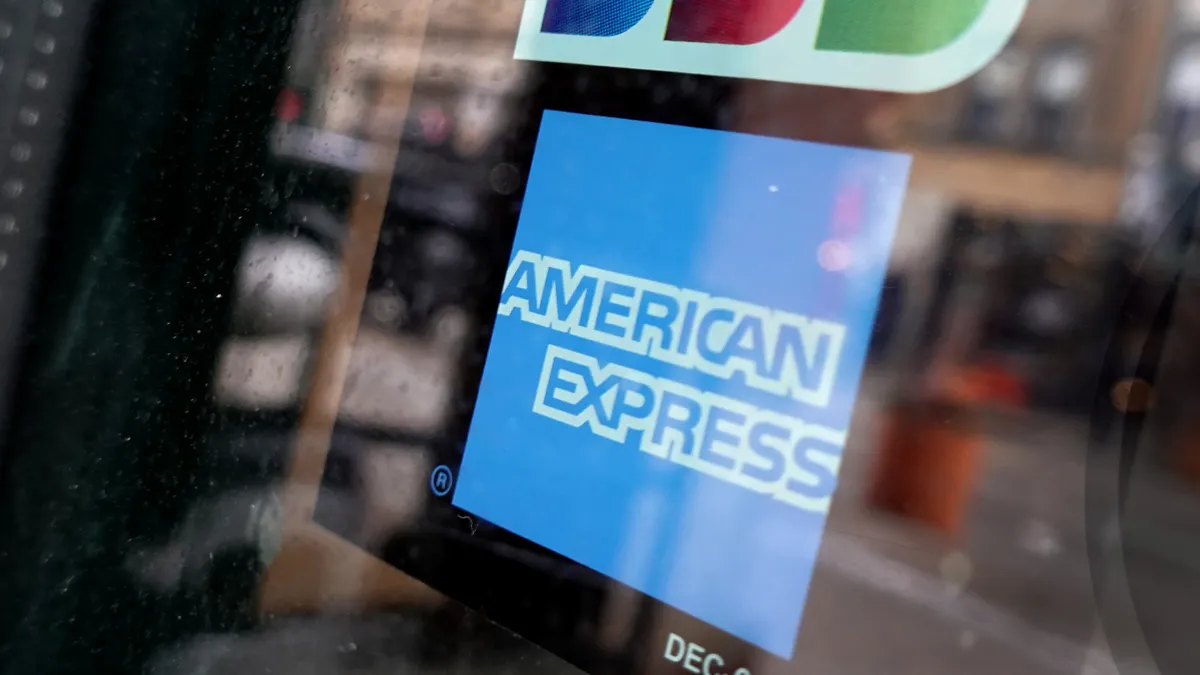Dive Brief:
- American Express second-quarter revenue, taking into account interest expense, climbed 31%, to $13.4 billion, the company said in an earnings report Friday. Touting record cardholder spending, the company’s total network payment volume for the quarter rose 25%, to $394.8 billion.
- Still, net income fell 14% year-over-year, to $1.96 billion. Expenses were $10.4 billion for the quarter, a 32% increase over the same quarter last year. The company noted both customer engagement and operating expenses have climbed, as Amex competes for cardholders and employees.
- New York-based Amex said cardholder spending was up 30% year-over-year on a foreign exchange adjusted basis. That was spurred by a rebound in travel and entertainment spending, as well as sustained growth in goods and services spending. Compared to the second quarter of 2019, travel and entertainment spending doubled, CEO Steve Squeri said during an earnings webcast with analysts. He doesn’t see that demand declining “anytime soon,” he added.
Dive Insight:
The current spending behaviors of Amex customers don’t suggest an economic downturn is imminent, Squeri asserted Friday. Emboldened by spending momentum and card acquisitions, the company raised its revenue growth expectations for the year, to between 23 and 25%, up from its adjusted projection of between 18 and 20% earlier this year.
“If I was thinking there was a slowdown in the next couple of quarters, I wouldn't be sitting here raising revenue 23% to 25%,” Squeri said.
Amex said it added 3.2 million new cards in the second quarter, and spending by Gen Z and millennial cardholders jumped 48% year-over-year on a foreign exchange adjusted basis, “significantly outpacing” other generations.
Those younger demographics make up 60% of all new consumer cardmembers, Squeri said. That’s making them lucrative addition for the company. Millennials and Gen Zers spend more than previous newcomers to Amex, and because they use so little cash and are “card-savvy,” “we’re getting a higher share of their wallets off the bat. That’s key,” Squeri said.
Delinquencies and write-offs hovered around historic lows in the second quarter, the company said in a filing with the Securities and Exchange Commission. While write-offs did tick up slightly this quarter, “they are trending a bit better than our expectations for the year,” said Chief Financial Officer Jeff Campbell.
The CFO noted the “highly analytical process” Amex employs as it considers new customers. The company expects delinquency and loss rates to increase slowly over time, but remain well below pre-pandemic levels, he said.
Campbell noted volumes in 2021 saw steep recovery as the year progressed, “so I do expect that our year-over-year growth rate will moderate as we progress through the rest of 2022,” he said.
Inflation is driving some modest benefit on spending, but it’s also putting pressure on operating expenses, especially in compensation, Campbell said. Operating expenses were $3.3 billion in the second quarter, up 28% over the same period last year.
Squeri defended that by saying “everything that we’re doing here is offensive.” Much of the increase in operating expenses is due to the addition of employees, he said, which is “not maybe a popular topic right now.”
“We’re adding people to make sure that we can continue the level of service that we have, and I don’t mind doing that, especially in a growth environment,” Squeri said. “You’re also seeing wage increases, and you have to pay more to keep your best talent.”













